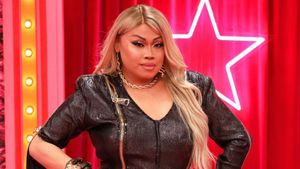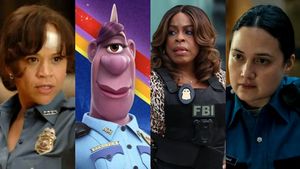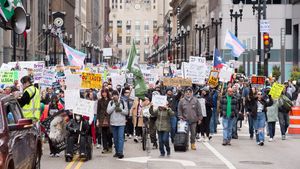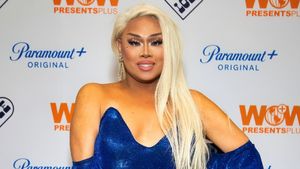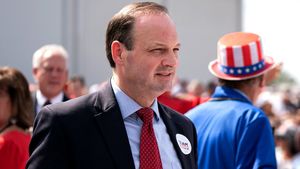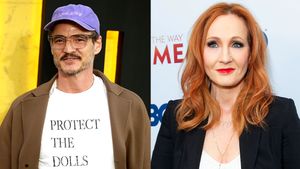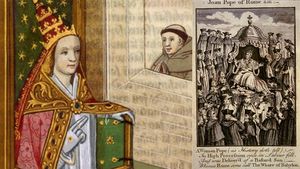 The dancers of The Missing Generation. Photo by Lydia Daniller
The dancers of The Missing Generation. Photo by Lydia Daniller
People just disappeared.
Survivors say that was one of the most disconcerting things about living through the early days of the AIDS epidemic.
“Girls were just disappearing,” recalls Cheryl Courtney-Evans, the Atlanta-based transgender activist who founded the support organization Transgender Individuals Living Their Truth. “If you missed seeing a girl that you were accustomed to seeing every night or all the time and you weren’t hearing about her being busted in some sort of sweep or raid or getting picked up, if you weren’t hearing about her calling somebody to bring some money down to the jail and you hadn’t seen her, you generally assumed that she was in the hospital.”
It was a tough period for transgender women, Courtney-Evans says: “If you didn’t see her [after] about a week or two weeks, well, she’s gone. And we knew they were in a pauper’s grave somewhere…we didn’t know their legal names, the names that we could find them under. So they would just disappear and we would just assume, well, there’s another one gone.”
Back in the 1980s and early ’90s little was known about the disease originally dubbed “the gay plague,” except that within weeks — sometimes within mere days or hours — of being diagnosed, tens of thousands of once-healthy and vibrant individuals withered and died. Many in the beginning were transgender women.
“You could go real fast,” adds Dee Dee Chamblee, another transgender woman in Atlanta. “You could have a cold one day and go the same day. It wasn’t no ‘have a cold today and maybe you die next week.’ It was like, ‘You have a cold today, you die today.’ ”
“It was unbelievable,” recalls Jimmy Mack, a gay, HIV-positive man who now blogs for The Body. “I watched so many of my friends, previously healthy men, die horrible deaths from an unknown disease that was first called GRID and then finally AIDS.”
Mack, who says he was “given a death sentence” at 29, moved to New York City in 1981 and came down with his first “AIDS-defining illness” that same year. It was a trying time, those early days when death seemed to attack overnight.

Ron Swanda (right) has lived with HIV for over 30 years, and is a longtime LGBT seniors' and HIV/AIDS-activist in Washington DC.
“We couldn’t even keep up with how many people were dead,” continues Chamblee, who is the founder of La Gender, a regional trans advocacy group. “It was like at least two or three every other day of your friends, of people you know. And we had no grief counseling or anything like that. So the community just kind of like blotted it dry.”
For some it would be more accurate to say blotted it out. Because while everyone knows that a generation of gay and bisexual men disappeared into the eternal night that was AIDS, far fewer realize that transgender women were dying too — in droves.
At the epidemic’s peak, AIDS-related fatalities in the United States were over 51,000 a year according to the Centers for Disease Control and Prevention. By the end of 1995, over half a million cases of AIDS had been reported in America, leading to 319,849 deaths.
We don’t know the number of trans women who died, although we do know that today trans women have one of the highest rates of HIV infection. A 2009 report from the National Institutes of Health found that nearly a third of transgender Americans are HIV-positive and more than 55 percent of black trans women are HIV-positive.
As Plus reported in April 2013, a “complex web of intertwining oppression and discrimination” puts trans women at higher risk of being infected. “HIV data collection methods often either mistakenly categorize transgender women as men who have sex with men, or don’t distinguish between transgender and nontransgender women,” the article noted, which is still the case.
The disappearance of these women and men certainly didn’t go unnoticed at the time — at least not to those of us in the LGBT community — and their absence has left a scar on survivors and the communities they left behind. A scar no less painful because it has become nearly invisible in the decades since.
Mack says he turned to drugs and alcohol to deal with the loss of “many, many friends, lovers, mentors, and heroes.” But once he got sober in 1992, Mack remembers, “It became clear to me that I had survived a plague so that I could tell my story and hopefully prevent others from getting it as well as do my part to dissipate the negative stigma attached to the disease.”
Many survivors like Mack have begun telling their stories. Last year Sean Strub’s memoir Body Counts recounted his life during the early days of AIDS in New York City; the HBO film of Larry Kramer’s The Normal Heart put a very handsome face (actor Matt Bomer’s) on his origin story; and Perry Halkitis’s anthology The AIDS Generation: Stories of Survival and Resilience included the stories of 15 gay poz men, making it the first book to document the life experience of long-term HIV survivors.
Still, those born after antiretroviral drugs transformed HIV from a usually fatal virus to a chronic, manageable condition often haven’t heard these stories. Younger people don’t even know what they’ve lost or what it means for queer and trans communities and even the country at large that more than half a million men and women simply vanished seemingly overnight at the prime of their lives.
But that doesn’t mean younger LGBT people don’t want to know about those dark days.
“There is a real hunger for information about this period, this history and these lost lives,” Chris Bartlett once told The New York Times. A former classics scholar, Bartlett developed an online memorial for Philadelphia men who died of AIDS in the 1980s and ’90s for GayHistory.Wikispaces.com.
Charles Stephens agrees. The founder of the Counter Narrative Project and coeditor of Black Gay Genius: Answering Joseph Beam’s Call tells Plus that younger black gay men want to know “our legacy,” including the work of Tongues Untied filmmaker Marlon Riggs, and authors Joseph Beam and Essex Hemphill, all of whom died of AIDS-related illnesses.
“[It] is really inspiring,” Stephens says of today’s youth. “They want to know more about the 1980s black gay renaissance.”
Six years ago, author Sarah Schulman, a lesbian activist and director of the ACT UP Oral History Project, complained to The New York Times, “There is absolutely no permanent social marker of the hundreds of thousands who died of AIDS in this country. There’s not even a postage stamp.”
Today there remains no stamp to commemorate those who died of AIDS complications in America, but there are a U.S. Postal Service AIDS awareness stamp and a variety of international AIDS-related stamps, a memorial stand of trees in San Francisco (the National AIDS Memorial Grove is located in Golden Gate Park), and not one but two AIDS monuments in development.
In May the Foundation for a National AIDS Monument received a $500,000 gift from Cedars-Sinai Medical Center, pushing the total amount raised by the Los Angeles nonprofit to over $1.2 million, making it all but certain it will succeed in building an AIDS monument in West Hollywood.
Meanwhile a coalition is developing the New York City AIDS Memorial, dedicated to the “recognition and preservation of the ongoing history of the AIDS crisis,” as the project’s website puts it. Having seen more than 100,000 residents die of AIDS-related illnesses, the city has the highest number of AIDS deaths in the country. Brooklyn-based architecture firm Studio a+i is designing the memorial, which will have an 18-foot steel canopy and sit at the entrance to the new St. Vincent’s Hospital Park in the West Village.
As these physical reminders of the epidemic’s toll break ground, other efforts to recover our history are uncovering stories that have been long silenced or ignored.
“One of the worst things AIDS took from us as black gay men has been our stories,” Stephens says. “Which is why we must keep telling them and keep remembering them. Our stories matter. We can’t just leave it up to white gay men to tell the story of the ’80s — we must put forth our own narratives.”
Stephens calls passing down that history to young gay black men critical “proof we existed” and says it’s necessary for them to “know that they not only have a community behind them, but a culture and a history.”
A similar impetus fuels award-winning queer dancer and choreographer Sean Dorsey’s sweeping and achingly wonderful new AIDS history performance piece, The Missing Generation.
“As a trans person, I’m passionate about documenting and sharing transgender experiences of early AIDS,” Dorsey tells Plus. “Despite being decimated by the early epidemic, trans women have been all but forgotten in most AIDS histories and narratives. Bringing these stories forward is really important to me.”
But why now?
“There is an incredible urgency to undertaking this project now,” Dorsey says. “During my lifetime we will see the passing of the last generation of people who actually experienced the early years of the AIDS epidemic firsthand. We are already rapidly losing our community’s stories.”
It was that necessity that pushed Dorsey to spend two years of his life researching that time period and traveling the country collecting stories from AIDS survivors.
“I think our culture has largely turned our backs not just on the early AIDS epidemic, but also on the generation of survivors who lived through those terrifying early years,” he says. “There was so much terror, so much death, so much mass death and grief that people individually had to pack a lot of it away just to keep functioning. But then we as a culture turned our backs on all those survivors.”
The director of Sean Dorsey Dance for the past 10 years, Dorsey is recognized as the nation’s first acclaimed transgender modern dance choreographer. He is also the founder and artistic director of Fresh Meat Productions, which creates year-round multidisciplinary transgender arts programs in San Francisco.
With The Missing Generation, Dorsey says he hopes to “capture and share part of this important history and reckon with the loss and grief this generation endured. And to collectively face this history and grieve and heal together.”
In some cities, a quarter of all gay and bi men and transgender women died of AIDS-related causes within a few years. It’s a world far removed from the lives of today’s millennials.
“Younger people don’t get taught this history,” Dorsey complains. “But young trans, queer, LGBT people lost an entire generation of elders. People who today would be their mentors, teachers, heroes, gay mothers, gay uncles. We need to grieve this together.”
For GayHistory.Wikispaces.com, Bartlett was able to create a database of men who died by searching obits, hospital records, and registries of both the Names Project Quilt and a local church that buried the unclaimed. But finding trans women lost to the disease is a much harder proposition. During that period many police and medical professionals routinely misidentified trans women as drag queens or transvestites. In death, these women were routinely stripped of their feminine accoutrements and counted by coroners and hospital workers as merely another dead gay man.
As Courtney-Evans recollects, most trans women had been “put out” by their families and were using names they hadn’t been given at birth. They may not have had identification with their real names. So when they died, these women just disappeared.
Many of the dead can be found on the Names Project Quilt, although because of stigma at the time, many of those commemorated with quilt patches were listed only by their first name, a nickname, or simply a single initial.
Perhaps there’s better luck if a trans woman (or man) died in New York City; there’s a project to document paupers’ graves in the city’s potter’s field, Hart Island. HartIsland.net has a database going back to 1980 and is searchable by name (if available), date of death, or where the person died (i.e. the name of a hospital). But be warned: 63,484 people have been buried in mass graves on Hart Island, and all of their stories certainly can’t be told.
But The Missing Generation isn’t as much about documenting those who died as it is about honoring the survivors and healing the pain of their loss — and ours.
“The people I met with were extraordinary,” Dorsey says of his “life-changing” cross-country journey documenting these stories. “These are people who lost dozens, hundreds, as many as a thousand friends and lovers and clients and patients and family. The warmth, generosity, humor, intelligence, insight, and wisdom that everyone shared blew my heart wide open.”
 ABilly S. Jones-Hennin (pictured above), a legendary bisexual activist in Washington, D.C., who Dorsey interviewed for the project, says the choreographer was “very comforting, assuring, and full of energy. Although it was my first interaction with him, it felt like we had known each other for decades.”
ABilly S. Jones-Hennin (pictured above), a legendary bisexual activist in Washington, D.C., who Dorsey interviewed for the project, says the choreographer was “very comforting, assuring, and full of energy. Although it was my first interaction with him, it felt like we had known each other for decades.”
Jimmy Mack, who says that despite telling his story to thousands of middle and high school students in the 15 years since he joined Love Heals, the Alison Gertz Foundation for AIDS Education, talking about those days was still “difficult and emotional.”
Not so for Jones-Hennin, who founded one of the country’s first black HIV organizations. “It was not a painful experience for me,” he admits, “because we have made progress. Yet we have so much more work to do on a personal, community, national, and global level. The painful part was recalling all of the men, women, and children lost due to complications associated with HIV and failure of communities, government, faith-based [groups], and health officials to respond in a compassionate manner.”
In addition to conducting interviews for two years, Dorsey did extensive archival research and hosted LGBT and HIV community residencies in six major U.S. cities to further expand his understanding of the AIDS era. In the end, he had 75 hours of oral history and enough material to write a book or two.
“I truly could have made a 200-hour long show!” Dorsey admits. “It was actually very painful to have to choose the final excerpts and stories that are featured in the show because they are all important and powerful for me.”
Over the course of his investigation, Dorsey says he began to sense common threads in all the stories he heard, which helped him develop the 65-minute performance piece based around four fantastic dancers and scores by four composers. “I built the show around the themes that began to emerge.”
One of those themes is about aging while HIV-positive. “I met with people who have been HIV-positive for 30 or 35 years,” he says. “What we don’t talk about as a culture, let alone in LGBTQ community, are the long-term realities of being HIV-positive. Being a senior and negotiating care homes or medical care as a transgender or LGB person. Being an invisible elder in our youth-obsessed queer culture.”
 Javon Egyptt is a longtime trans-activist who spoke with Dorsey in her hometown - New York City.
Javon Egyptt is a longtime trans-activist who spoke with Dorsey in her hometown - New York City.
From talking with women like Chamblee and men like Mack, Dorsey came away sounding like a health care activist too.
When antiretroviral medication first became available the dosage was set way too high, Chamblee recalls. “The medicines that they had was so harsh and the side effects and the way…it made you look, your eyes and everything, most people did not want to go out like that,” she says. “I stopped taking it in like the first six months, because it had really just depleted me of everything. I had nothing left.”
Even though today’s treatments turn HIV into a manageable disease, Dorsey adds, “We’re only starting to understand some of the very intense long-term side effects of being on HIV meds for decades. Some long-term survivors are dealing with additional painful diseases and conditions prematurely because they are being brought on by long-term use of HIV meds. And no one I talked to will be able to afford their HIV meds once they ‘retire.’ ”
While the resulting performance by Sean Dorsey Dance’s multigenerational troupe is “a love letter to a forgotten generation of survivors, those who witnessed and experienced the loss,” Dorsey stresses that The Missing Generation isn’t just for those over 40.
“All audiences can relate to this show,” he says, because “it speaks to all of us. All of us want to be loved, all of us want to live, all of us want community and safety and happiness. All of us carry rage at injustice and all of us want healing.” Indeed, San Francisco Chronicle critic Allan Ulrich called the show “a metaphor for dealing with any inexorably destructive force. At moments, The Missing Generation seems like a primer for living well; at other times, it seems a prescription for just living.”
The performance features a score (which took 350 hours to create) that layers original music with voices and life stories collected on Dorsey’s travels. “What audiences hear are actual excerpts of the actual interviews,” Dorsey explains. He says we should all pay attention to these AIDS survivors. “I think we talk and ask and listen and advocate and fight like hell with and for them,” he says.
The Missing Generation, he says, is one tiny step in that direction. The performance premiered in San Francisco and is now on a 20-city tour that includes stops in D.C., Pittsburgh, Boston, Atlanta, Los Angeles, and Maui between now and fall 2016. (For locations, times, tickets and more information, visit SeanDorseyDance.com.)
“Sometimes we are frozen by [a sense of] overwhelm in the face of big problems,” Dorsey says. “But what I want people to take away is, just do it. Just show up. If we just show up with an open heart and sit with each other, we can hold what comes. We can hold all of it. But first we need to show up for each other. With heart. I hope this project sparks our hearts in that direction.”
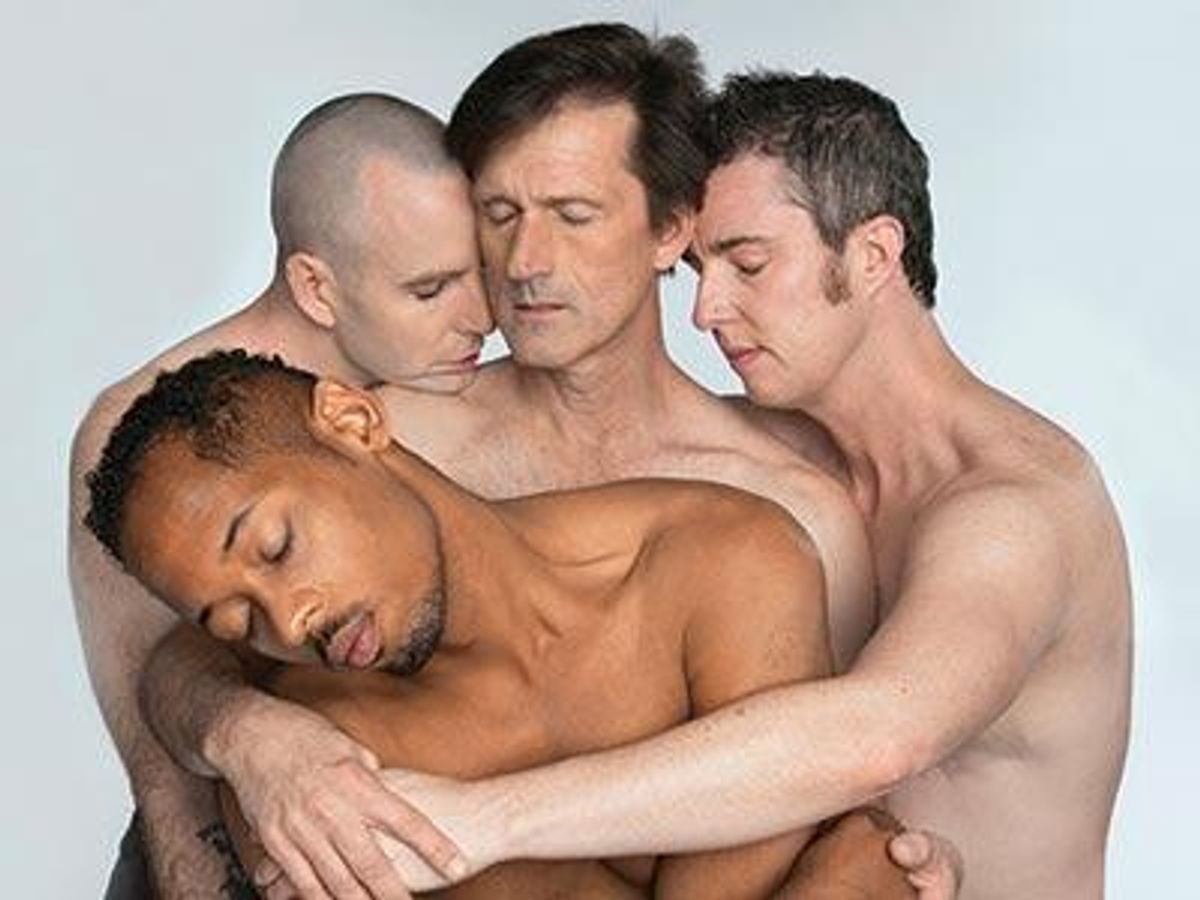
 The dancers of The Missing Generation. Photo by Lydia Daniller
The dancers of The Missing Generation. Photo by Lydia Daniller
 ABilly S. Jones-Hennin (pictured above), a legendary bisexual activist in Washington, D.C., who Dorsey interviewed for the project, says the choreographer was “very comforting, assuring, and full of energy. Although it was my first interaction with him, it felt like we had known each other for decades.”
ABilly S. Jones-Hennin (pictured above), a legendary bisexual activist in Washington, D.C., who Dorsey interviewed for the project, says the choreographer was “very comforting, assuring, and full of energy. Although it was my first interaction with him, it felt like we had known each other for decades.” Javon Egyptt is a longtime trans-activist who spoke with Dorsey in her hometown - New York City.
Javon Egyptt is a longtime trans-activist who spoke with Dorsey in her hometown - New York City.































